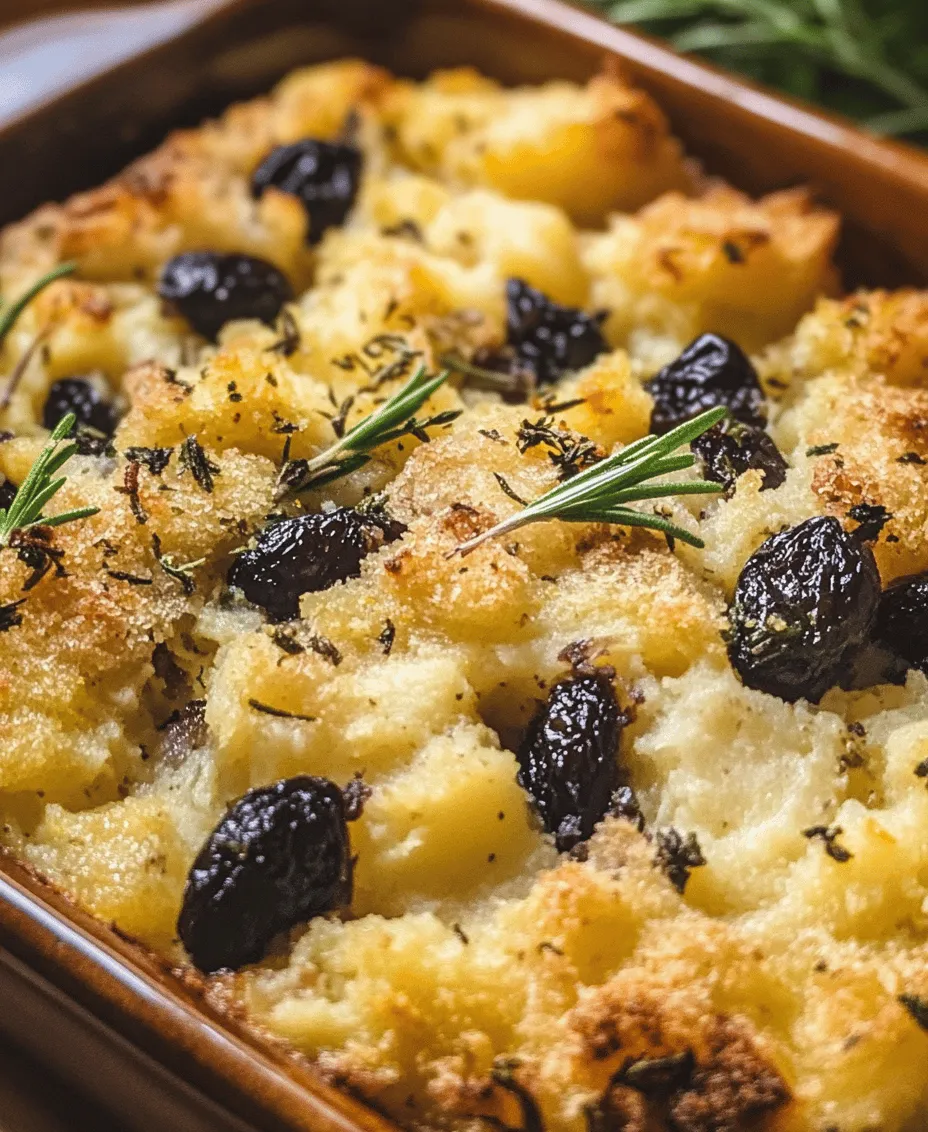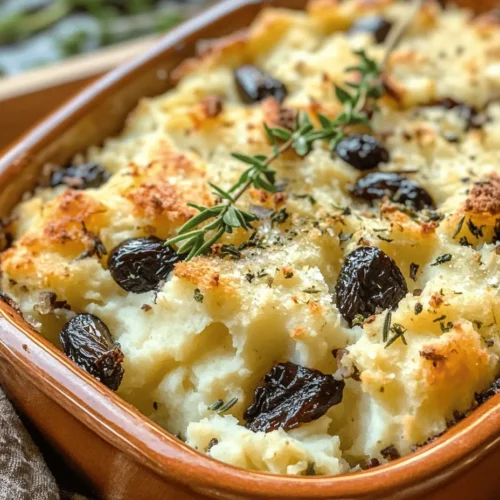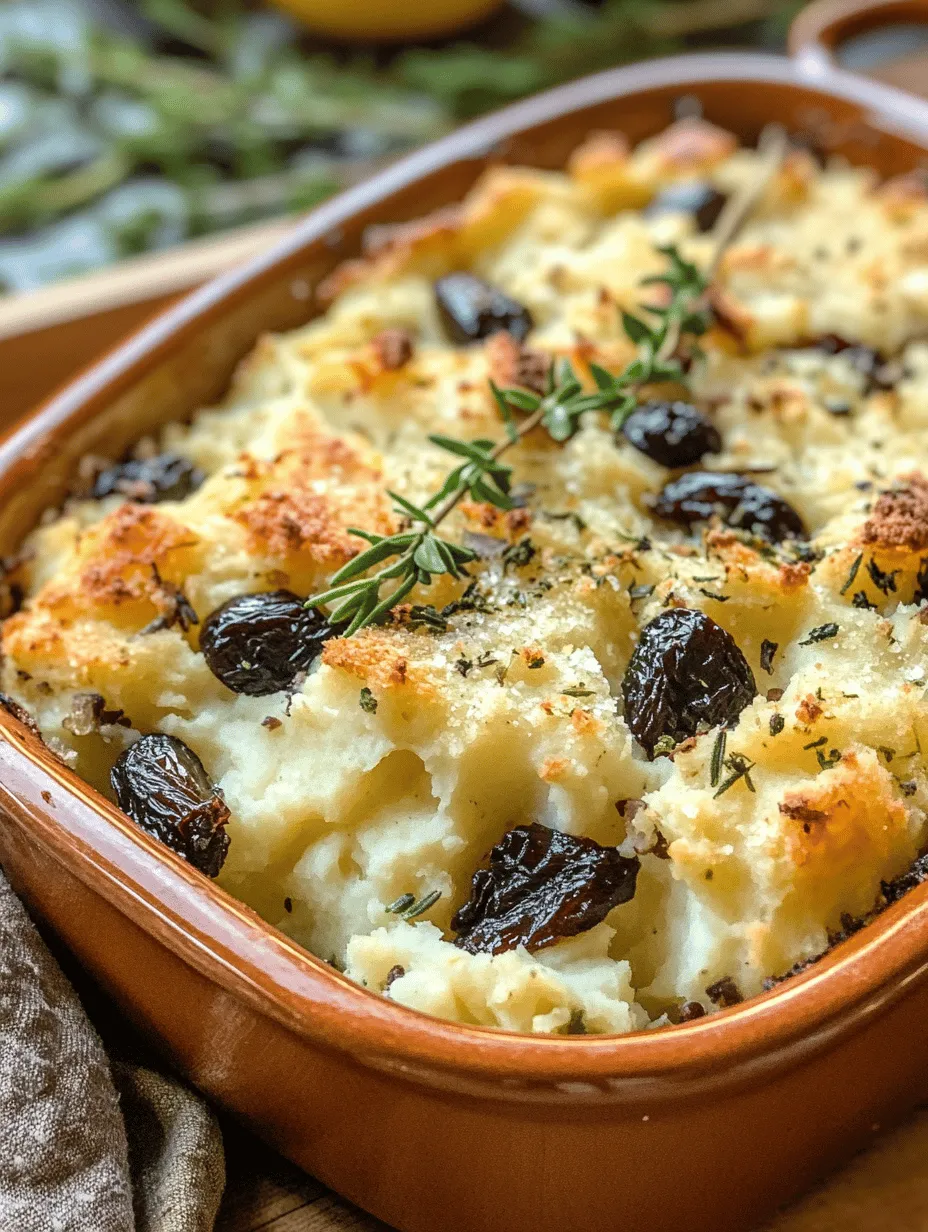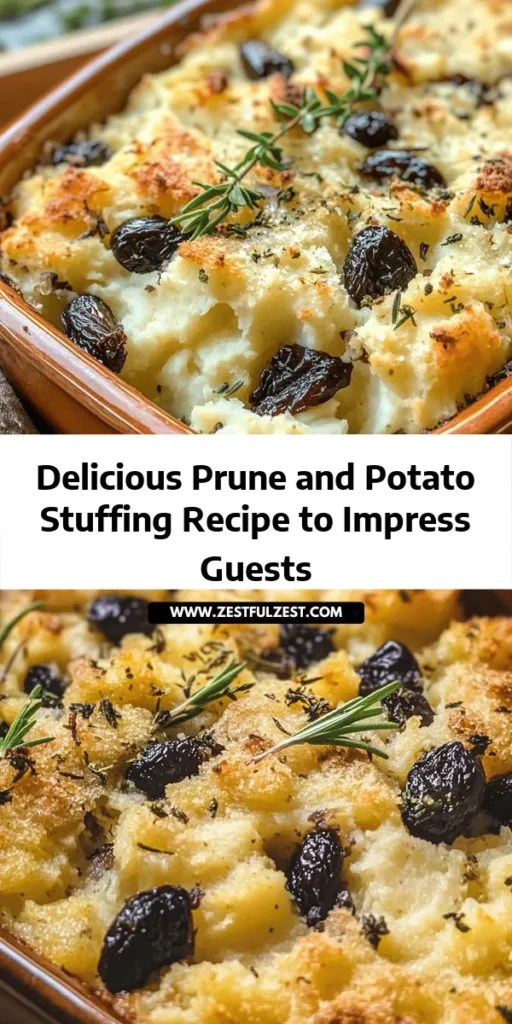Introduction
Stuffing is a cherished dish that graces tables across the globe, particularly during the festive season and family gatherings. This beloved side dish, often served alongside roasted meats and seasonal vegetables, has become synonymous with holiday meals. While traditional stuffing usually revolves around bread and herbs, the creative culinary landscape has paved the way for unique variations that tantalize the palate. One such delightful recipe is prune and potato stuffing—a harmonious blend of flavors that tantalizes both traditional and adventurous eaters alike.
The combination of tender mashed potatoes and sweet, chewy prunes results in a stuffing that is not only delicious but also deeply satisfying. The rich, buttery texture of mashed potatoes serves as a perfect backdrop for the natural sweetness of prunes, creating a dish that is both comforting and intriguing. Beyond its delightful taste, this stuffing also boasts significant health benefits. Potatoes are an excellent source of vitamins and minerals, while prunes are known for their high fiber content, antioxidants, and natural sweetness. Together, they create a wholesome dish that you can feel good about serving at your next holiday meal or family gathering.
The Allure of Prune and Potato Stuffing
The history of stuffing is as rich and varied as the ingredients that go into it. Across different cultures, stuffing has played a significant role in culinary traditions, often representing a way to utilize leftover bread and ingredients. From the classic bread stuffing of American Thanksgiving to the rice-based fillings of Middle Eastern cuisines, stuffing has evolved over centuries, adapting to local tastes and available ingredients.
As families gather to celebrate holidays, stuffing often becomes a focal point of the meal, symbolizing nourishment and togetherness. Its evolution over time reflects changing culinary trends, with home cooks experimenting with different flavors and textures to create their own signature recipes. Prune and potato stuffing is a perfect example of this evolution—a dish that marries the savory and sweet, inviting diners to experience the best of both worlds.
Prunes, often overlooked in modern cooking, are a key ingredient that adds depth and moisture to the stuffing. Their natural sweetness complements the earthy flavor of potatoes, creating a unique flavor profile that excites the taste buds. This dish invites guests to explore an unexpected combination that bridges the gap between traditional stuffing and modern culinary innovation.
Ingredient Breakdown
Mashed Potatoes
The foundation of our prune and potato stuffing is the mashed potatoes. Choosing the right type of potatoes is crucial for achieving the perfect texture. Starchy potatoes, such as Russets or Yukon Golds, are ideal for mashing due to their light and fluffy consistency. They absorb flavors beautifully, making them the perfect base for our stuffing. When preparing the mashed potatoes, it’s important to cook them until they are fork-tender, then mash them until smooth and creamy. This creates a luscious backdrop for the flavorful additions that will follow.
Pitted Prunes
Next, we have pitted prunes, which are essential to the stuffing’s unique flavor profile. Often mistakenly associated only with digestive health, prunes are packed with fiber and antioxidants, making them a powerhouse of nutrition. Not only do they add a natural sweetness to the stuffing, but they also contribute moisture, ensuring that the final dish remains tender and flavorful. When selecting prunes for this recipe, look for plump, dark varieties that are free from added sugars. Their rich flavor complements the earthy notes of the potatoes, creating a delicious contrast that elevates the dish.
Diced Bread
In any stuffing recipe, bread plays a crucial role in providing structure and texture. For prune and potato stuffing, you can choose between white or whole grain bread, depending on your preference. White bread will yield a softer, more delicate stuffing, while whole grain bread adds a hearty bite and nutty flavor. Regardless of your choice, it’s essential to use slightly stale bread, as this allows it to absorb the flavors of the broth and other ingredients without becoming mushy. Cut the bread into small cubes, creating a perfect balance between the creamy potatoes and the chewy texture of the bread.
Aromatics
Aromatics such as onion and garlic are vital for developing the flavor of the stuffing. As they sauté, they release fragrant oils that infuse the dish with a savory depth. Finely dice the onion and mince the garlic, then sauté them until they are translucent and fragrant. This step not only enhances the flavor but also adds a wonderful aroma that fills the kitchen, inviting everyone to gather around. The combination of these aromatics with the sweetness of the prunes creates a complex flavor profile that is both comforting and intriguing.
Herbs and Spices
Herbs and spices are the final touch that elevate the stuffing to a new level. Fresh rosemary and thyme bring a delightful earthiness, while a hint of lemon zest adds brightness and acidity. Rosemary, with its pine-like aroma, pairs beautifully with the earthy potatoes, while thyme introduces a subtle floral note that complements the prunes. Lemon zest adds a refreshing contrast to the richness of the dish, balancing the flavors and enhancing the overall experience. These herbs and spices not only contribute to the flavor but also make the stuffing visually appealing, creating a colorful and aromatic side dish.
Vegetable Broth and Butter
To bind the ingredients together and add moisture, vegetable broth and butter are essential. The broth infuses the stuffing with flavor, while the butter adds richness and helps to create a cohesive mixture. When combining the mashed potatoes, prunes, and bread, gradually add the vegetable broth until the stuffing reaches your desired consistency. The goal is to create a moist mixture that holds together without being overly wet. The butter will melt into the stuffing as it bakes, enhancing the overall flavor and creating a golden, crisp top that is irresistible.
With these ingredients, you are well on your way to creating a delightful prune and potato stuffing that will impress your family and friends. The balance of flavors and textures makes this dish a standout at any gathering, offering a delicious alternative to traditional stuffing recipes. In the next part of this article, we will dive into the step-by-step instructions for preparing and baking this unique stuffing, ensuring that it becomes a cherished addition to your holiday table.

Step-by-Step Cooking Instructions
Creating the perfect prune and potato stuffing is an art that combines careful preparation with thoughtful cooking techniques. To ensure you achieve the best results, follow these detailed steps meticulously.
Preparing the Ingredients
1. Chop the Vegetables: Start by finely chopping your onions and garlic. The key to a flavorful stuffing lies in how well you sauté these aromatics. Aim for a fine chop to maximize their release of flavors into the stuffing. Additionally, peel and cube your potatoes into uniform pieces to ensure even cooking.
2. Soak the Prunes: If your prunes are particularly dry, soak them in warm water or a splash of apple juice for about 15 minutes. This softens them and enhances their natural sweetness, which will balance the savory flavors of the stuffing.
3. Measure the Seasonings: Gather all herbs and spices you’ll be using, such as thyme, sage, salt, and pepper. Having these ready will streamline the cooking process and ensure you don’t miss any essential flavor components.
Sautéing Onions and Garlic
4. Heat the Pan: In a large skillet, heat about 2 tablespoons of olive oil or butter over medium heat. Allow the fat to warm up, but don’t let it smoke.
5. Sauté the Aromatics: Add the chopped onions first, stirring occasionally, and cook for about 5-7 minutes until they are translucent and slightly golden. This caramelization process is crucial as it adds depth to your stuffing. Next, add the minced garlic and sauté for an additional minute, just until fragrant. Be careful not to burn the garlic, as it can turn bitter.
Mixing the Stuffing Ingredients
6. Combine Ingredients: In a large mixing bowl, combine the sautéed onions and garlic with the cubed potatoes and chopped prunes. Sprinkle in your pre-measured seasonings along with some fresh herbs if desired. Gently mix everything together, ensuring the prunes and potatoes are evenly distributed throughout the mixture.
7. Achieving the Right Texture: The goal is to maintain a chunky yet cohesive texture. Avoid over-mixing, which can lead to a mushy stuffing. The mixture should hold together when pressed but still have distinct pieces of potato and prune.
8. Add Broth: Slowly pour in vegetable or chicken broth while mixing gently. The amount of broth will depend on your desired consistency; start with half a cup and add more if needed until the mixture is moist but not soggy.
Baking the Stuffing
9. Prepare the Baking Dish: Preheat your oven to 375°F (190°C). Grease a large baking dish with non-stick spray or butter. Transfer the stuffing mixture into the baking dish, spreading it out evenly.
10. Cover with Foil: Cover the dish tightly with aluminum foil. This step is crucial because it allows the stuffing to steam and prevents it from drying out during the initial baking phase.
11. Bake: Place the covered dish in the preheated oven and bake for 25 minutes. This allows the flavors to meld together beautifully.
12. Final Browning: After 25 minutes, remove the foil and continue baking for an additional 15-20 minutes until the top is golden brown and slightly crispy. This step adds a delightful texture to the stuffing, creating a contrast with the soft interior.
Serving Suggestions
Prune and potato stuffing is not only delicious but also versatile, making it suitable for a variety of occasions. Here are some suggestions on how to serve it effectively:
1. Holiday Feasts: This stuffing is a quintessential addition to Thanksgiving or Christmas dinners. Pair it with roast turkey or glazed ham for a traditional feast. Its sweet and savory profile complements rich meats beautifully.
2. Family Gatherings: Bring this dish to family potlucks or gatherings. It’s an excellent side dish that pairs well with roasted chicken or pork. The unique flavor of prunes adds an unexpected twist that will impress your relatives.
3. Vegetarian Dishes: For a vegetarian alternative, serve this stuffing alongside stuffed bell peppers or a hearty vegetable casserole. Its flavors enhance the meal without overshadowing the main dish.
4. Variations: Feel free to customize your stuffing by adding chopped nuts like walnuts or pecans for added crunch. You can also incorporate other dried fruits such as apricots or cranberries for extra flavor and texture. Consider adding sautéed mushrooms for an earthy touch or incorporating celery for a bit of crunch.
Nutritional Information
Understanding the nutritional benefits of your food is essential, especially when preparing dishes like prune and potato stuffing. Here’s a breakdown of what you can expect per serving (approximately 1 cup):
– Calories: 200-250
– Protein: 4g
– Carbohydrates: 35g
– Dietary Fiber: 5g
– Fat: 5g
– Vitamins: Rich in Vitamin A, Vitamin C, and various B vitamins from the potatoes and prunes, which contribute to overall health.
– Minerals: Contains potassium and magnesium, which are vital for heart and muscle function.
This stuffing is a healthier alternative to traditional bread-based stuffings, as it incorporates nutrient-dense ingredients such as potatoes and prunes, which are high in fiber and can aid digestion. The inclusion of whole foods means you can enjoy a comforting dish without excessive calories.
Conclusion
Prune and potato stuffing is a delightful dish that brings together unique flavors and wholesome ingredients, making it a standout choice for any meal. Its versatility ensures it can be enjoyed during special occasions or as a comforting side dish throughout the year.
With its sweet and savory profile, this stuffing not only enhances main dishes but also offers a nutritious alternative to traditional stuffing options. As you embrace this recipe, you’ll discover the joy of combining flavors that create a memorable culinary experience.
Encourage your friends and family to try out this recipe; its delightful blend of textures and flavors will undoubtedly solidify its place in your culinary repertoire. Enjoy the process of making this stuffing, and relish the satisfaction that comes from serving a dish that is both nourishing and indulgent.



